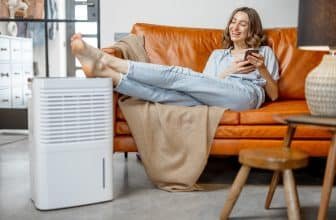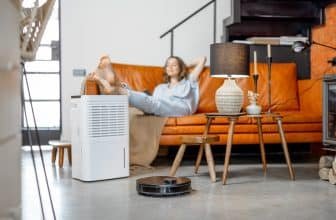Ionic Air Purifiers: How They Work to Remove Air Pollutants
Ionic air purifiers are becoming increasingly popular as people become more aware of the importance of clean air. These devices use a unique technology to remove pollutants from the air, making it safer and healthier to breathe. Understanding how ionic air purifiers work and their principles can help individuals make informed decisions when choosing the right air purifier for their home or office.

Ionic air purifiers use a process called ionization to remove pollutants from the air. They release negatively charged ions into the air, which attach to positively charged particles such as dust, pollen, and smoke. Once these particles are charged, they are attracted to the positively charged plates inside the purifier, where they are trapped and removed from the air. This process is highly effective in removing a wide range of pollutants, including allergens, bacteria, and viruses.
Key Takeaways
- Ionic air purifiers use ionization to remove pollutants from the air.
- The air cleaning process involves releasing negatively charged ions into the air, which attach to positively charged particles and remove them from the air.
- Understanding the principles of ionic air purifiers can help individuals make informed decisions when choosing an air purifier for their home or office.
Understanding Ionic Air Purifiers
Ionic air purifiers are a type of air purifier that use electrical charges to remove pollutants from the air. They work by emitting negatively charged ions into the air, which attach themselves to positively charged particles, such as dust, pollen, and smoke, making them heavier and causing them to fall to the ground or onto a collector plate.
Principles of Operation
The principle of operation of an ionic air purifier is based on the fact that particles in the air have an electrical charge. The air purifier emits negatively charged ions that attach themselves to the positively charged particles in the air. This makes the particles heavier and causes them to fall to the ground or onto a collector plate. This process is called ionization.
Key Components
The key components of an ionic air purifier are the ionizer, which emits the negatively charged ions, and the collector plate or filter, which collects the particles that have been ionized. Some ionic air purifiers also have fans to help circulate the air and increase the efficiency of the unit.
Types of Ionic Air Purifiers
There are several types of ionic air purifiers, including electrostatic air purifiers, ion generators, and ozone generators. Electrostatic air purifiers use a series of plates to attract and collect particles. Ion generators emit negatively charged ions into the air to attach to positively charged particles. Ozone generators work by emitting ozone into the air, which reacts with pollutants to form harmless molecules.
Overall, ionic air purifiers can be an effective way to remove pollutants from the air. However, it is important to note that some ionic air purifiers can produce ozone, which can be harmful to humans and pets. Therefore, it is important to choose an ionic air purifier that does not produce ozone and to use the unit according to the manufacturer’s instructions.
Air Cleaning Process
Ionic air purifiers work by using an electrostatic charge to remove harmful particles from the air. The process begins with ionization, followed by the removal of contaminants, and finally, filtration and collection.
Ionization Mechanism
Ionic air purifiers use a process called corona discharge to create negatively charged ions. The device contains a needle-like electrode that emits a high voltage electrical current. This current charges the air molecules, which then attract and bind to positively charged particles such as dust, pollen, mold spores, smoke, pet dander, bacteria, and viruses, among others.
Removal of Contaminants
Once the particles are charged, they are attracted to a collector plate with an opposite charge. This electrostatic attraction causes the particles to stick to the plate, effectively removing them from the air. The collector plate can be easily removed and cleaned, and the particles can be disposed of safely.
Filtration and Collection
In addition to ionization and electrostatic precipitation, some ionic air purifiers also use a filtration process. These devices typically have a pre-filter that captures larger particles such as pet hair and dust, followed by a HEPA filter that captures smaller particles such as allergens and pollutants.
Overall, ionic air purifiers are effective at removing airborne particles and pollutants from the air. However, it is important to note that while they can remove certain types of contaminants, they may not be effective against all pollutants. Additionally, some ionic air purifiers emit ozone, which can be harmful to human health. Therefore, it is important to choose a high-quality ionic air purifier that does not produce harmful levels of ozone.
Health and Environmental Impact
Ionic air purifiers have been touted as a solution to indoor air pollution, which can contain a variety of pollutants, including volatile organic compounds (VOCs) and lung irritants. However, there are concerns about their health and environmental impact.
Benefits for Respiratory Health
Ionic air purifiers can remove pollutants from the air, which can be beneficial for respiratory health. For example, they can help reduce the risk of respiratory problems associated with indoor air pollution, such as allergies and asthma. They can also help reduce the risk of respiratory conditions such as lung irritants, which can cause coughing, wheezing, and other symptoms.
Concerns about Ozone Production
One of the main concerns about ionic air purifiers is that they can produce ozone, which can be harmful to human health and the environment. While some ozone is produced naturally in the atmosphere, high levels of ozone can cause respiratory problems, such as coughing, chest pain, and shortness of breath.
Ionic air purifiers can produce ozone as a byproduct of the charging process. While the amount of ozone produced is lower than that of an ozone generator, a type of air purifier that purposely releases ozone into the air to “sanitize” it, it can still be harmful to human health and the environment.
It is important to note that while ionic air purifiers can remove pollutants from the air, they may not be effective at removing all types of pollutants, such as viruses like SARS-CoV-2, the virus that causes COVID-19. It is recommended to use additional measures, such as wearing masks and improving ventilation, to reduce the risk of COVID-19 transmission indoors.
Evaluating Air Purifier Performance
Air purifiers are designed to remove pollutants and other harmful particles from the air, but not all air purifiers are created equal. When evaluating air purifier performance, there are several metrics to consider.
Efficiency Metrics
One important metric when evaluating air purifiers is the Clean Air Delivery Rate (CADR). This metric measures the volume of clean air produced by the air purifier per minute. The higher the CADR, the more effective the air purifier is at removing pollutants from the air.
Another important metric is the efficiency of the air purifier’s filters. HEPA filters are considered the gold standard in air purification because they are able to remove particles as small as 0.3 microns with an efficiency of 99.97%. Carbon filters are also effective at removing pollutants, particularly odors and volatile organic compounds (VOCs).
Comparing Technologies
When comparing air purifier technologies, it is important to understand how each technology works. Ionic air purifiers, for example, use negatively charged ions to attract and remove pollutants from the air. While these air purifiers are effective at removing particles from the air, they can also generate ozone, which can be harmful to human health.
HEPA air purifiers, on the other hand, use a physical filter to capture pollutants and other harmful particles from the air. These filters are highly effective at removing pollutants, but they do need to be replaced periodically to maintain their efficiency.
In conclusion, when evaluating air purifier performance, it is important to consider factors such as CADR, filter efficiency, and technology. By understanding these metrics, consumers can make informed decisions about which air purifier is right for their needs.
Practical Considerations
Placement and Maintenance
When it comes to placing ionic air purifiers, it is important to consider the size of the room and the placement of the device. To ensure optimal air purification, it is recommended to place the purifier in the center of the room, away from walls, floors, carpets, and curtains. This allows for maximum air circulation and ensures that the device can effectively remove pollutants from the air.
Maintenance is also an important consideration when it comes to ionic air purifiers. It is recommended to clean the device regularly, following the manufacturer’s instructions. This may include wiping down the device with a damp cloth or replacing the filter. Regular maintenance ensures that the device can continue to effectively remove pollutants from the air.
Noise Levels and Energy Usage
Ionic air purifiers are generally quiet, making them a good choice for use in bedrooms or other quiet spaces. However, it is important to note that some models may produce a small amount of noise. When choosing an ionic air purifier, it is recommended to look for models with low noise levels.
Energy usage is another important consideration when it comes to ionic air purifiers. While they are generally energy-efficient, it is important to choose a model that fits your needs. Some models may have additional features, such as smart air technology or DIY air purifier options, which may impact energy usage.
Additional Features
When choosing an ionic air purifier, there are a number of additional features to consider. Some models may include activated charcoal filters, which can help to remove odors from the air. Others may include additional filters or fans to improve air circulation.
It is also important to consider the size and portability of the device. Portable air cleaners are a good choice for those who need to move the device from room to room, while larger models may be better suited for larger spaces.
Overall, ionic air purifiers are a great way to improve indoor air quality. By considering factors such as placement, maintenance, noise levels, energy usage, and additional features, it is possible to choose a model that fits your needs and ensures optimal air purification.
Frequently Asked Questions

How do ionizers function to clean the air?
Ionizers function by emitting negatively charged ions into the air. These ions attach themselves to positively charged particles like dust, pollen, and smoke, causing them to become heavier and fall to the ground where they can be vacuumed or wiped away. This process is known as electrostatic precipitation.
Can ionizing air purifiers effectively remove viruses?
While ionizers can help reduce the number of airborne viruses, they are not a foolproof method of eliminating them. According to the Environmental Protection Agency (EPA), air purifiers that use ionizers alone are not effective at removing all pollutants, including viruses. Therefore, it is recommended to use an ionizer in conjunction with other air purification methods, such as HEPA filters or UV-C light.
What are the potential side effects of using an ionizer air purifier?
One potential side effect of using an ionizer air purifier is the production of ozone. Ozone is a gas that can irritate the lungs and worsen asthma symptoms. However, many modern ionizers are designed to limit ozone production to safe levels. It is important to check the product specifications before purchasing an ionizer air purifier to ensure it meets safety standards.
What distinguishes ionizer air purifiers from traditional air purifiers?
Traditional air purifiers use filters to trap pollutants, while ionizer air purifiers use negatively charged ions to remove pollutants from the air. This makes ionizer air purifiers a good option for people who are sensitive to the sound of a fan or the cost of replacing filters. However, it is important to note that ionizers may produce ozone and are less effective at removing larger particles like pet hair and dander.
Is it safe to use an ionizer in a car for air purification?
It is generally safe to use an ionizer in a car for air purification. However, it is important to ensure that the ionizer is designed for use in a vehicle and does not produce excessive amounts of ozone. It is also important to follow the manufacturer’s instructions for placement and use.
How do anion air purifiers differ in performance compared to other types?
Anion air purifiers, also known as negative ion air purifiers, are a type of ionizer air purifier that emit negatively charged ions into the air. They are generally less effective at removing larger particles like pet hair and dander, but can be effective at removing smaller particles like dust and pollen. It is important to note that anion air purifiers may also produce ozone, and should be used in accordance with the manufacturer’s instructions.






